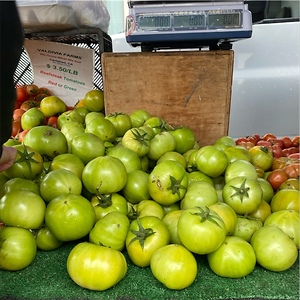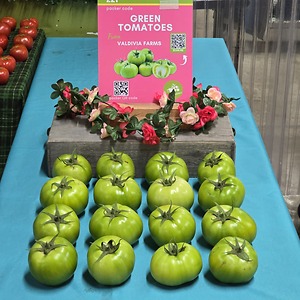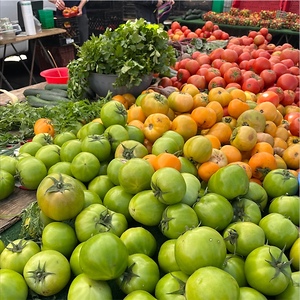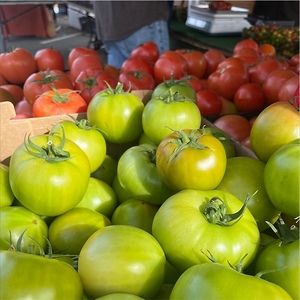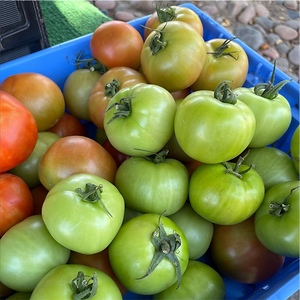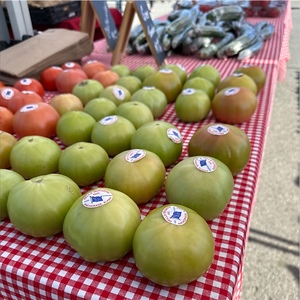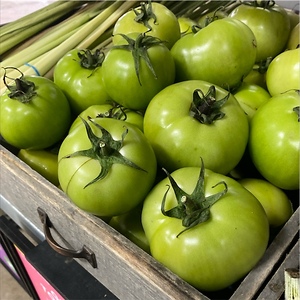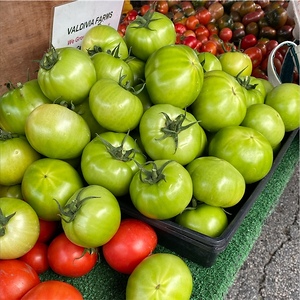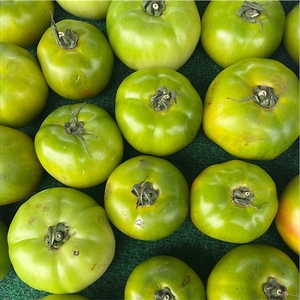

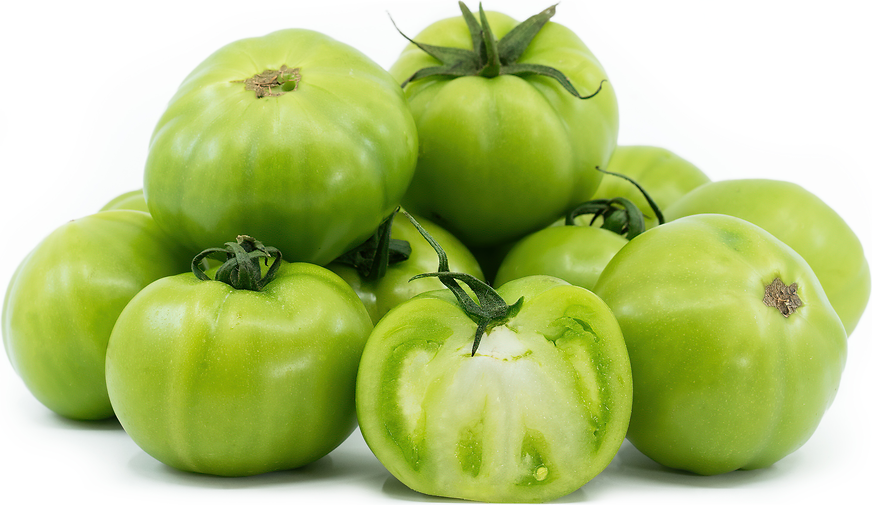
Green Tomatoes
Estimated Inventory, 10 lbs : 6.76
This item was last sold on : 07/13/25
Description/Taste
Green tomatoes vary in size and shape, depending on the variety, and can be small to large, ranging from 4 to 10 centimeters in diameter. The tomatoes are found in cherry, cocktail, plum, slicer, and beefsteak types, and most have a round, oblong, or oval shape with a plump, bluntly curved nature. Green tomatoes appear in shades of light green, olive green, and dark green, and some are enveloped in striping and streaked patterns. The skin is semi-thick to thin, firm, and taut, either having a shiny finish or a powdery, matte sheen, changing with the variety. Underneath the surface, the pale green to green-white flesh is dense, firm, and crisp with a lightly succulent, crunchy, and chewy consistency. Some types of Green tomatoes will have soft and juicy flesh, while others are firm and hold their shape. The flesh encases chambers filled with tiny seeds suspended in a gelatinous liquid. Green tomatoes are edible raw or cooked and carry different flavors with each variety. Overall, Green tomatoes are more acidic than ripe red versions and have a refreshing, bright, tart, tangy, sour, and subtly sweet taste with light fruity notes.
Seasons/Availability
Green tomatoes are available year-round, with a peak season in the late summer and fall.
Current Facts
Green tomatoes, botanically classified as Solanum lycopersicum, are a category of green-skinned varieties belonging to the Solanaceae or nightshade family. It is important to note that there are two different types of Green tomatoes. The first type is tomatoes that have been harvested young before they have fully ripened. These kinds of Green tomatoes can come from any variety and are characteristically firm with an acidic, tart, and sometimes sour taste. Young Green tomatoes can be picked anytime throughout the growing season but are often seen in markets at the end of the season when cooler temperatures stop the fruits from ripening on the vine. The second type of Green tomatoes are varieties specifically bred to retain their green coloring once ripe. These varieties are often heirlooms and are softer, juicier, and sweeter than the first type mentioned above. Popular varieties of mature Green tomatoes include Green Zebra, Green Moldavians, Artisan Green Tiger, Cherokee Green, Malakhitovaya Shkatulka, Berkley Tie Dye Green, and many others. Both types of Green tomatoes are favored for culinary preparations and are considered seasonal delicacies, especially in the United States. Green tomatoes are edible raw or cooked, complementing a wide array of sweet and savory dishes.
Nutritional Value
Green tomatoes vary in vitamin and mineral content, depending on the specific variety. In general, Green tomatoes contain vitamins A, C, E, and K to maintain healthy organs, aid in faster wound healing, guard the cells against free radical damage, and strengthen the immune system. Green tomatoes also provide fiber to regulate the digestive tract and minerals like magnesium, potassium, calcium, phosphorus, and iron. Magnesium helps the body control nerve functions, while potassium balances fluid levels. Calcium and phosphorus support bone and teeth health, and iron develops the protein hemoglobin for oxygen transport through the bloodstream. Beyond vitamins and minerals, Green tomatoes contain solanine and tomatine, naturally occurring glycoalkaloids. Tomatine may have anti-inflammatory and antibiotic properties, but more research needs to be conducted before conclusions can be made. Solanine occurs minimally in Green tomatoes and is considered toxic if ingested in large amounts. Despite this potentially toxic nature, mass quantities of Green tomatoes would have to be consumed in one sitting beyond a normal serving for them to become dangerous. Some individuals may also have a natural sensitivity to solanine, causing an upset stomach.
Applications
Green tomatoes are typically acidic, tart, tangy, and subtly sweet and are suited for raw or cooked culinary preparations. The two main types of Green tomatoes will vary in uses. Unripe, young Green tomatoes hold their shape and are preferred for preparations where the flesh is firmer. Green varieties that remain green at maturity are softer and carry a complex flavoring, similar to ripe tomatoes. Both varieties can be used in recipes calling for Green tomatoes, but it is advised to use the correct type of Green tomato based on the desired texture. Green tomatoes are popularly chopped into salads, layered onto sandwiches, or diced into salsa. They can also be sliced and mixed with red tomatoes to create a colorful bruschetta or pickled for extended use as a tangy condiment. Try blending Green tomatoes into chilled soups for a refreshing twist. In addition to raw preparations, Green tomatoes are simmered into jams and sauces or made into relishes or ketchup. Varieties of Green tomatoes can be grilled and added to caprese, used as a topping over pizza, or cooked into egg-based dishes like omelets, frittata, and benedict. They can also be incorporated into casseroles, skewered and grilled, cooked into risotto, or simmered into pasta sauces. While less common, Green tomatoes can be baked into a sweet pie, similar to how green apples are used for their tangy flavor. Green tomatoes pair well with herbs such as basil, cilantro, mint, and dill, cheeses including goat, parmesan, and feta, avocado, arugula, and aromatics such as garlic, onion, and shallots. Whole, unwashed Green tomatoes should be stored at room temperature in a cool, dry, and dark location. Once opened or used in a culinary dish, it is recommended to keep the tomatoes in the fridge.
Ethnic/Cultural Info
Green tomatoes are battered in cornmeal and fried in a famous American dish known by the simple and straightforward name of fried green tomatoes. The origins of fried green tomatoes are heavily debated throughout the United States. Some food historians believe the dish originates in the South, while others point to the North or Midwest as its site of creation. Fried green tomatoes consist of slices of young, unripe tomatoes dredged in a rich batter and fried to create a savory, slightly sour, and salty flavor. The fried slices are traditionally served with a dipping sauce, and recipe variations are found across the United States. The first recorded recipes for fried green tomatoes appeared in the 19th century through Jewish immigrant cookbooks. Additional recipes were published in newspapers in midwestern and northern cities in the 20th century, from 1900 to 1919. It is unknown when fried green tomatoes were first made in the southern United States, but some sources claim the dish may have been made during the Great Depression. Fried green tomatoes became a well-known dish in the late 20th century after the release of author Fannie Flagg’s novel, “Fried Green Tomatoes at the Whistle Stop Café,” published in 1987. In 1992, the book was made into a movie, and Americans across the United States were re-introduced to the tomato dish, spurring restaurants to add fried green tomatoes to their menus. Fried green tomatoes are a staple dish in the Southern United States, and the crunchy battered tomatoes are sold in neighborhood cafes, high-end dining establishments, or made at home.
Geography/History
Green tomatoes are descendants of wild species native to South America. Early types of tomatoes were domesticated in ancient times and were spread throughout Central and South America as a favored culinary crop. Tomatoes were later carried by Spanish and Portuguese explorers to Europe beginning in the 15th and 16th centuries, where they spread in cultivation due to trade. Over time, tomatoes were planted in North America, and new varieties were selectively bred for specific characteristics. Green tomatoes have a varied history, as many varieties are encompassed under this general name. Each type of Green tomato will have a separate origin story, and Green tomatoes are a global crop, used in various preparations worldwide. As a general category in the United States, Green tomatoes were used as a culinary ingredient in the late 19th and early 20th centuries and faded from popularity briefly in the mid-20th century. They later experienced a resurgence in the late 20th century and are sold in the present day as a seasonal, specialty culinary ingredient. Green tomatoes are typically found in local markets in their growing regions.
Featured Restaurants
Restaurants currently purchasing this product as an ingredient for their menu.
| Books and Records | San Diego CA | 619-310-5298 |
| Del Mar Country Club | Rancho Santa Fe CA | 858-759-5995 |
| Brigantine Escondido | Escondido CA | 760-743-4718 |
| Brigantine La Mesa | La Mesa CA | 619-465-1935 |
| Espadin | Temecula California | 951-383-5585 |
| Fairmont Grand Del Mar | San Diego CA | 858-314-1975 |
| The Farm Golf Club | Rancho Santa Fe CA | 858-756-5585 |
| Plant Based Meals | San Diego CA | 858-255-0590 |
| Portside Pier (Brigantine) | San Diego CA | 858-268-1030 |
| The Victorian at Hill Street | Oceanside CA | 442-266-8285 |
| Brigantine Del Mar | Del Mar CA | 858-481-1166 |
| Brigantine Pt Loma | San Diego CA | 619-224-2871 |
| Brigantine Poway | Poway CA | 858-486-3066 |
| Copper Kings | San Marcos CA | 323-810-1662 |
| Lodge at Torrey Pines Main | San Diego CA | 858-453-4420 |
| Claire's on Cedros - SKSB | Solana Beach CA | 858-259-8597 |
| Le Papagayo (Encinitas) | Encinitas CA | 760-944-8252 |
| Viewpoint Brewing Co. | Del Mar CA | 858-205-9835 |
| Brigantine Coronado | Coronado CA | 619-435-4166 |
| The Guild Hotel | San Diego CA | 619-764-5108 |
| Brigantine Imperial Beach | Imperial Beach CA | 619-591-1350 |
| Understory | San Diego CA | 516-507-0101 |
| WaterBar | San Diego CA | 619-308-6500 |
| Valley View Casino & Hotel (Black&Blue) | Valley Center CA | 760-291-5500 |
| US Grant Hotel Grill | San Diego CA | 619-232-3121 |
Recipe Ideas
Recipes that include Green Tomatoes. One
Podcast



